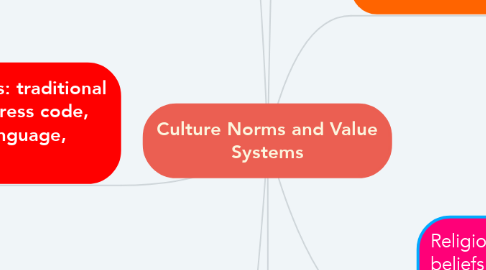
1. Others determinants: traditional activities, custom, dress code, skin, styles, body language, behavior,...
2. Political Philosophy
2.1. Define
2.1.1. Shapes country's economic and legal systems
2.1.2. It is possible that democratic societies that emphasize a mix of collectivism and individualism. Totalitarian societies that are not collectivist
2.1.3. Collectivism tend toward totalitarianism, individualism tend to be democratic
2.2. Collectivism and individualism
2.2.1. Collectivism
2.2.1.1. The primacy of collective goals over individual goals
2.2.1.2. Individual’s right be restricted
2.2.2. Individualism
2.2.2.1. The philosophy that an individual should have freedom in his or her economic and political pursuits
2.3. Democratic and totalitarian
2.3.1. Democracy
2.3.1.1. Government is by the people, exercised either directly or through elected representatives
2.3.1.2. Citizens periodically elect individuals to represent them make decisions
2.3.2. Totalitarianism
2.3.2.1. One person or political party exercises absolute control over all spheres of human life and prohibits opposing political parties
2.3.2.2. Four major forms of totalitarianism: communist totalitarianism, theocratic totalitarianism, tribal totalitarianism, right-wing totalitarianism
3. Social Structure: society's basic social organization
3.1. Individuals and Groups
3.1.1. Individuals: the basic building block of social organization
3.1.1.1. Individualism and entrepreneurship
3.1.1.2. Western, Managerial mobility
3.1.1.3. Lack of loyalty and commitment
3.1.1.4. Competition between individuals, difficult to build teams
3.1.2. Groups: two or more individuals with shared sense of identity and interact with each other in structured ways
3.1.2.1. Identification
3.1.2.2. Eastern, No managerial mobility
3.1.2.3. Lack of dynamism and entrepreneurship
3.1.2.4. Lifetime employment, cooperation and team work
3.2. Social stratification: stratified on a hierarchical basis into social categories, typically defined by family background, occupation, and income
3.2.1. Social Mobility: individuals can move out of the strata into which they are born
3.2.1.1. Caste system
3.2.1.1.1. A closed system of stratification
3.2.1.1.2. Not change position during individual's lifetime
3.2.1.2. Class system
3.2.1.2.1. A opend system of stratification
3.2.1.2.2. position person can be changed through their achievements or luck
3.2.2. Significance attached to social strata in a business context
3.2.2.1. Class consciousness
3.2.2.1.1. People tend to perceive themselves in terms of their class background
3.2.2.1.2. Shapes their relationships with members of other classes
4. Economic Philosophy
4.1. Market economy
4.1.1. All productive activities are privately owned and are not planned by anyone
4.1.2. Production is determined by the interaction of supply and demand and signaled to producers through the price system
4.2. Command economy
4.2.1. The government plans the products
4.2.2. All businesses are state owned
4.3. Mixed economy
4.3.1. Mix market economies and command economies
4.3.2. Many fields are private ownership and free market mechanisms or state ownership and government planning
5. Religion: a system of shared beliefs and rituals that are concerned with the realm of the sacred
5.1. Ethical systems: a set of moral principles, or values, that are used to guide and shape behavior
5.2. Confucianism and Confucian ethics influence behavior and shape culture in parts of Asia
5.3. Four greatest dominate
5.3.1. Christianity
5.3.2. Islam
5.3.3. Hinduism
5.3.4. Buddhism
5.4. Confucianism
6. Language: the spoken and the unspoken means of ommunication, one of the defining characteristics of a culture
6.1. Spoken language: primary to establishing quality business relationships
6.1.1. Countries with more than one spoken language often have more than one culture
6.1.2. Knowledge of the local language is beneficial, and in some cases, critical for business success
6.2. Unspoken language: nonverbal communication, nonverbal cues are culturally bound
6.2.1. Nonverbal cues: eyebrows, fingers/thumbs, hand gestures, feet, personal space, body gestures
6.2.2. A failure to understand the nonverbal cues of another culture can lead to a communication failure

